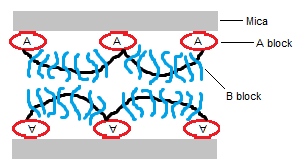A new polymer has a molecular structure and physical properties very similar to those of lubricin, a protein that lubricates the opposing bone surfaces in moving (articulating) joints of the body. Chemistry researchers from the University of Montreal, Carnegie Mellon University, and the University of California, Santa Barbara reported the synthesis of the polymer in the Journal of the American Chemical Society (April 9, 2014). A synthetic material that mimics lubricin could be important for extending the life of artificial joints, which currently require replacement every 10–15 years because of wear. See also: Friction; Joint (anatomy); Lubricant; Polymer; Prosthesis; Tribology; Wear
In the most common type of joint in the human body, known as diarthrodial joints (such as those in the fingers and hips), the surfaces where the bones meet are covered with articular cartilage inside a capsule filled with synovial fluid. Coating the cartilage are springy, brushy lubricin molecules, anchored at each end by molecular groups. The lubricin molecules prevent the cartilage on opposing bones in the joint from directly touching and thereby protect the joints from friction and wear. See also: Bone; Cartilage
To simulate lubricin, the researchers synthesized a triblock (ABA) copolymer with an A block on each end for attaching the molecule to a mica test substrate and a “bottlebrush” B block in between, which has a flexible backbone and springy bristle-like side chains. The flexible backbone of the bottlebrush allows the polymer to hang off the substrate and form compressible loops, while the side-chain bristles allow the polymers to slide past each other when in contact. When the researchers tested the polymer, they found it to resist high compression and to have low friction forces during sliding. See also: Copolymer; Macromolecular engineering; Relations among structure, properties, and function in biological materials

Such polymer lubricants will most likely find industrial applications long before they could be (if ever) used in the human body. But there is a need for a synthetic synovial fluid for testing potential orthopedic devices, and a polymer lubricant could end up being one component of it. Currently, bovine serum is used as the test fluid but it is largely inadequate as a match for the lubricating properties of synovial fluid.





